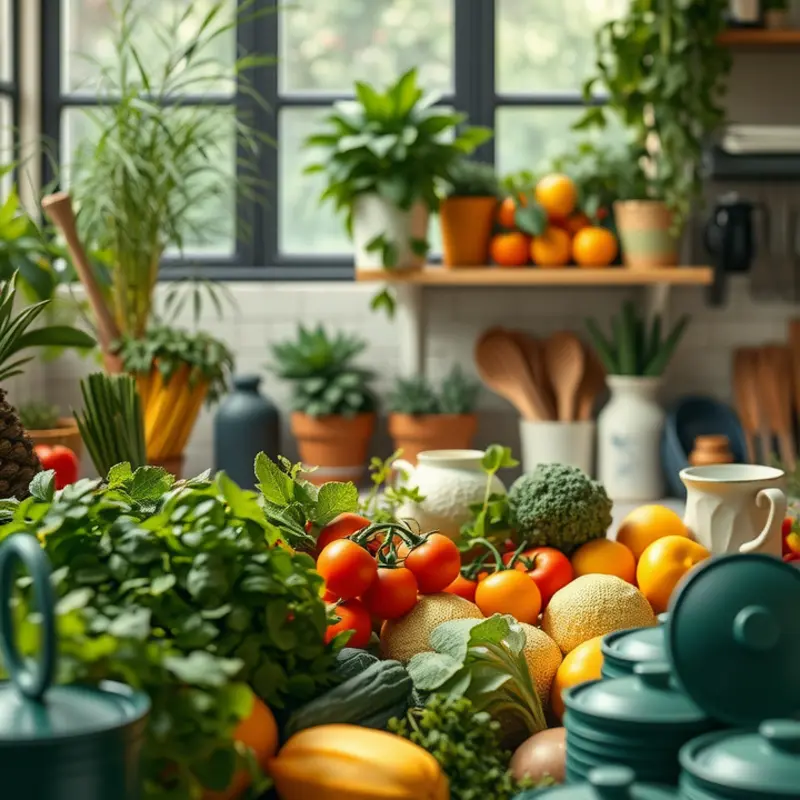Navigating the kitchen with sustainability in mind can seem daunting, but making eco-friendly choices is easier than you think. Adopting sustainable home-cooking techniques not only nurtures the environment but also enhances your culinary experience. By focusing on local ingredients, mindful cooking practices, and storage solutions, individuals can make impactful decisions that support their ecological values. Dive into the world of sustainable cooking as we explore practical methods to create nourishing meals—while significantly reducing your carbon footprint.
Sourcing Local Ingredients: The Heart of Sustainability

Sourcing local ingredients shifts the balance towards sustainability by reducing carbon footprints and supporting local economies. Farmers’ markets are exemplary venues to discover the freshest, most vibrant seasonal produce. They offer insights into local agriculture and introduce consumers to the farmers who cultivate their food. Walking through these markets, you engage directly with producers, gaining firsthand knowledge about growing practices and the environmental methods they employ.
Community-Supported Agriculture (CSA) is another sustainable venture. CSA programs function as partnerships between consumers and farmers. By subscribing, members receive a share of the farm’s harvest, which can include vegetables, fruits, and sometimes dairy or meat products. This model not only ensures you get fresh produce but also provides farmers with upfront capital, minimizing financial risks for them and fostering community business growth.
Grocery stores prioritizing local sourcing also contribute to sustainability by reducing transportation emissions and offering fresher goods. These stores often feature sections dedicated to seasonal produce, allowing shoppers to pick sustainably grown fruits and vegetables.
Why Seasonal Matters
Cooking with seasonal ingredients is advantageous for health and the environment. Seasonal produce is harvested at peak ripeness, which means fruits and vegetables have more nutrients and flavors. Studies show that seasonal eating can lead to improved diet quality. Choosing to cook with what’s in season ensures a varied and nutritious diet that aligns with natural cycles.
Environmental benefits are also notable. Transportation and storage emissions decrease when food is sourced locally in season. Additionally, this practice encourages biodiversity and helps maintain healthy ecosystems.
Practical Tips for Incorporating Local Ingredients
Begin by visiting your local farmers’ market or enrolling in a CSA program. Engage with vendors to learn about the best offerings and their farming practices. When shopping, consider fruits and vegetables currently in season. Use this as inspiration for your meal planning.
For those new to seasonal cooking, start by focusing on familiar recipes and replacing conventional ingredients with local alternatives. Not only does this foster culinary creativity, but it also bridges the gap between intention and action in sustainable cooking. Try exploring minimal prep dinner ideas, which can easily incorporate local ingredients to streamline your cooking process.
As you source locally, remain mindful of reducing food waste. Planning meals around your market finds helps ensure that you consume everything purchased—an essential aspect of eco-friendly living. Embrace this practice not only as a step toward sustainability but also as a journey of discovering flavors and crops that reflect the rhythm and richness of the region you live in.
Mindful Cooking Practices: Techniques for Low-Waste Cooking

Mastering mindful cooking techniques can dramatically reduce waste and enhance your sustainability efforts. One of the simplest ways to start is by utilizing every part of your ingredients. Embrace the philosophy of cooking from root to peel: vegetable tops, stems, and even the skins hold nutritional value and can enhance the flavor of your dishes. For instance, carrot tops can transform into a vibrant pesto; potato skins crisp into delightful snacks. Be creative with what might seem like scraps.
Meal planning is another cornerstone of low-waste cooking. Organize your meals for the week by prioritizing ingredients that perish quickly. This approach not only reduces waste but also cuts down unnecessary trips to the grocery store. Consider incorporating practical ingredient batching into your routine, allowing you to use up what you have in inventive ways. For more inspiration, check out this guide on practical ingredient batching.
Batch cooking is a powerful tool not only for efficiency but also for sustainability. Prepare larger portions of meals that can be repurposed throughout the week. A hearty stew can morph into a filling pie or a delightful pasta sauce. This method saves energy, time, and keeps your diet diverse without repetitive meals.
Preserving and pickling are time-honored techniques that can breathe new life into produce nearing the end of its prime. Not only does it prevent waste, but it also adds exciting flavors and textures to your meals. Homemade pickled vegetables can add a zing to a myriad of dishes, elevating simple meals with minimal effort.
Leftovers are often viewed as a culinary conundrum. Yet, with a little creativity, they can become the star of your kitchen. Transform last night’s roast vegetables into a colorful curry or blend leftover rice with spices for savory pancakes. Be bold in reimagining your dishes.
Finally, consider adding composting to your kitchen routine. Even with low-waste efforts, some scraps are inevitable. A compost bin can turn peels and cores into nutrient-rich soil for your garden, closing the loop on food waste. Many communities offer excellent resources to guide you in starting composting at home.
Each of these strategies transforms every meal into an opportunity for mindful consumption. They empower you to contribute positively to the planet while enjoying delicious and inventive dishes. As you refine these practices, you’ll find joy and satisfaction in seeing your kitchen waste diminish, truly embodying a greener approach to cooking.
Final words
Sustainable home-cooking techniques create a bridge between our kitchens and a thriving ecosystem. By embracing local ingredients and minimizing waste, every meal becomes an act of kindness towards the planet. Not only does sustainable cooking nourish our bodies, but it also supports local economies and preserves natural resources. You have the power to influence positive change with every choice you make in your kitchen. Remember, every small action contributes to a larger movement. Cooking sustainably is not just a trend; it’s a path to a healthier lifestyle and more vibrant world. Let’s rise to the challenge together!








